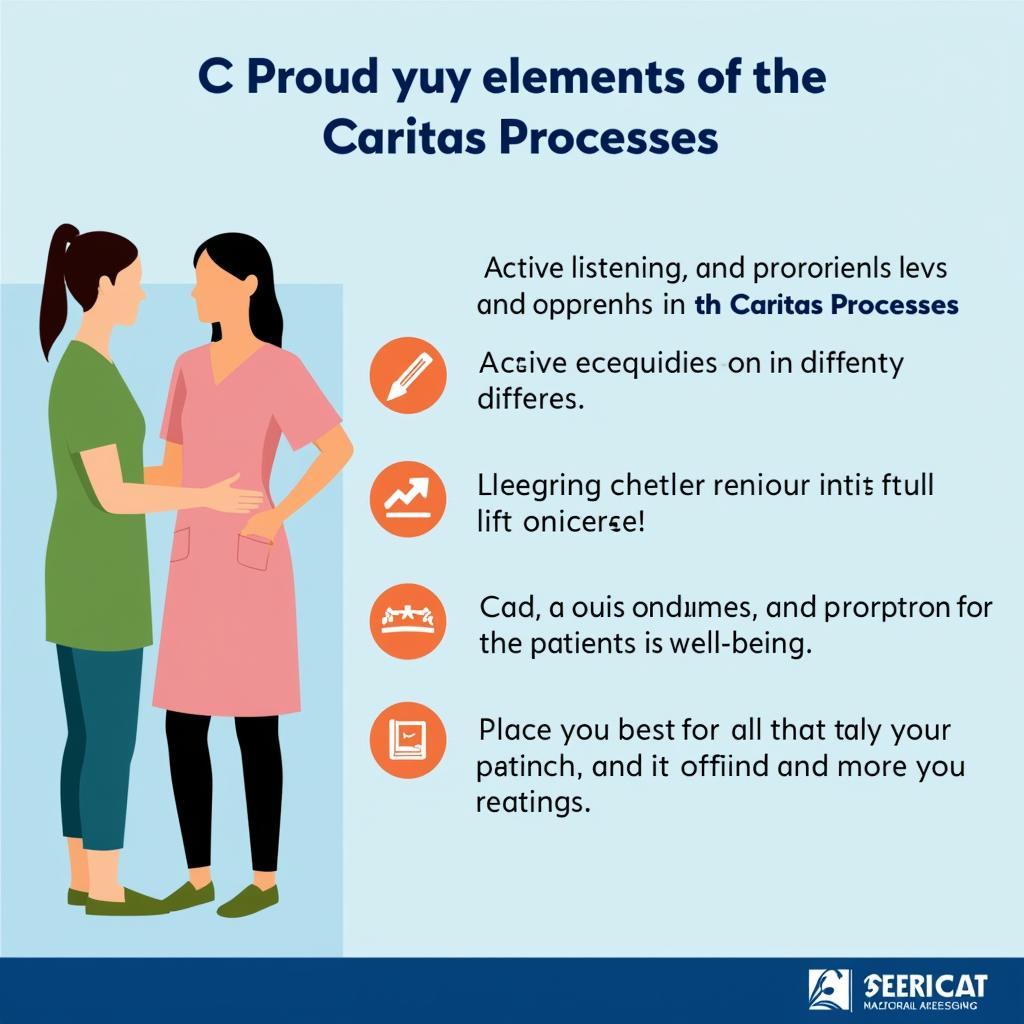Nursing practice tools derived from Watson’s Theory of Human Caring provide a framework for nurses to deliver compassionate, holistic care. These tools help nurses connect with patients on a deeper level, addressing not only their physical ailments but also their emotional, spiritual, and social needs. This approach fosters healing and promotes overall well-being, aligning with Watson’s belief in the interconnectedness of mind, body, and spirit.
Understanding Watson’s Theory of Care and its Practical Applications
Watson’s theory emphasizes the importance of the transpersonal caring relationship between nurse and patient. This relationship is built on mutual respect, trust, and understanding, allowing the nurse to truly see the patient as a unique individual. By embracing this philosophy, nurses can create a healing environment that supports the patient’s journey toward wholeness.
The Caritas Processes: A Foundation for Caring Practice
The ten Caritas Processes are central to Watson’s theory, offering practical guidance for nurses in their daily practice. These processes encourage nurses to cultivate loving-kindness, authentic presence, and a deep sensitivity to the patient’s experience.
- Embrace altruistic values and practice loving-kindness with self and others. This involves cultivating compassion and empathy, extending kindness not only to patients but also to oneself.
- Instill faith-hope. Nurses can foster hope by helping patients connect with their inner strength and belief in their ability to heal.
- Cultivate a sensitivity to one’s self and to others. Self-awareness and emotional intelligence are crucial for nurses to build meaningful connections with patients.
- Develop a helping-trusting, human caring relationship. Trust is the cornerstone of the nurse-patient relationship, enabling open communication and vulnerability.
- Promote and accept the expression of positive and negative feelings. Creating a safe space for patients to express their emotions, both positive and negative, is essential for healing.
- Systematically use the scientific problem-solving method for decision making. Integrating scientific knowledge with caring practices ensures holistic and effective care.
- Promote transpersonal teaching-learning. Empowering patients through education enables them to actively participate in their healing process.
- Create a healing environment at all levels, physical, metaphysical, and interpersonal. The environment plays a significant role in healing, encompassing physical comfort, emotional support, and spiritual connection.
- Assist with basic needs, with an intentional caring consciousness. Attending to even the most basic needs with compassion and mindfulness can make a profound difference in a patient’s experience.
- Open and allow for spiritually mysterious and unknown existential dimensions of one’s own life-death; soul care for self and the one-being-cared-for. Acknowledging the spiritual dimension of life and death can bring comfort and meaning to patients facing illness and mortality.
 Caritas Processes in Nursing Practice
Caritas Processes in Nursing Practice
Practical Tools for Implementing Watson’s Theory
Several tools have been developed to help nurses integrate Watson’s theory into their daily practice. These include:
- The Caring Assessment Tool (CAT): This tool helps nurses assess the patient’s needs from a holistic perspective, considering physical, emotional, and spiritual dimensions.
- The Caring Behaviors Inventory (CBI): This inventory measures the frequency with which nurses demonstrate caring behaviors, providing feedback for professional development.
- Reflective journaling: Reflecting on patient interactions and personal experiences allows nurses to deepen their understanding of caring and identify areas for growth.
Benefits of Using Watson’s Theory in Nursing Practice
Integrating Watson’s theory into nursing practice has numerous benefits for both patients and nurses. Patients experience increased satisfaction, improved healing outcomes, and a greater sense of well-being. Nurses, in turn, report greater job satisfaction, reduced stress, and a renewed sense of purpose in their work.
Enhanced Patient Outcomes
By addressing the whole person, nurses can create a healing environment that promotes physical, emotional, and spiritual well-being. This holistic approach leads to improved patient satisfaction and better health outcomes.
Increased Nurse Satisfaction
Watson’s theory empowers nurses to connect with their patients on a deeper level, fostering a sense of meaning and purpose in their work. This leads to increased job satisfaction and reduced burnout.
Conclusion
Nursing practice tools derived from Watson’s theory of care offer a powerful framework for delivering compassionate, holistic care. By embracing these tools and principles, nurses can transform the patient experience and create a more humane and healing healthcare system. These tools not only benefit patients but also enhance the professional lives of nurses, fostering a deeper sense of purpose and fulfillment in their calling to care.
FAQ
- What are the core principles of Watson’s theory of care?
- How can I use the Caritas Processes in my daily nursing practice?
- What are the benefits of using the Caring Assessment Tool (CAT)?
- How does reflective journaling enhance caring practices?
- How can I integrate Watson’s theory into my workplace?
- What are some examples of nursing interventions based on Watson’s theory?
- How can Watson’s theory help improve patient outcomes?
For further assistance, please contact us via WhatsApp: +1(641)206-8880, Email: [email protected] or visit our office at 910 Cedar Lane, Chicago, IL 60605, USA. Our customer service team is available 24/7.

Leave a Reply